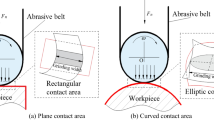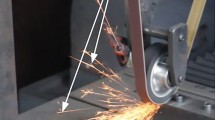Abstract
Belt grinding is a material processing operation which is capable of producing parts to high dimensional accuracy, excellent finish surface, and surface integrity. Unlike turning or other metal cutting operations that use geometrically well-defined tools, belt grinding involves tool geometry and cutting actions that are not well defined. Therefore, it is quite difficult to obtain a comprehensive theoretical model to predict the grinding depth. As well known, the strain rate is very high in grinding with abrasive tools, which results in substantial heat produced in the shear zone. Sparks are produced when the hot chips thrown out during the process, get oxidized, and burn in the atmosphere. Spark is an inherent feature for most dry grinding process. An approach on material removal rate monitoring in belt grinding by spark field measurement is proposed. The size of the spark field is a visualized reflection of the number of chips instantaneous produced in grinding. Features of spark field related to the material removal rate are analyzed and quantified. With this method, the coupling between the grinding parameters is no need to be considered. Experimental results indicate that the changing of grinding parameters has a different impact on the feature values of the spark field. Feature values of the spark field, such as area, boundary, and density, show a tight correlation with the material removal rate. The resolution accuracy of spark features on the grinding depth is studied. The correct rate of the grinding depth identification can reach more than 95% for the area, and density features of the spark field with the resolution range greater than 10 μm. The analysis indicates that the proposed method is effective and easy-to-accomplish for material removal rate monitoring in belt grinding.


















Similar content being viewed by others
Change history
17 May 2021
A Correction to this paper has been published: https://doi.org/10.1007/s00170-021-07063-w
References
Xu XH, Yang YF, Pan GF, Zhu DH, Yan SJ (2018) A robotic belt grinding force model to characterize the grinding depth with force control technology. ICIRA, pp 287–298
Huang H, Gong ZM, Chen XQ, Zhou L (2002) Robotic grinding and polishing for turbine-vane overhaul. J Mater Process Technol 127(2):140–145
Xiao GJ, Huang Y (2016) Equivalent self-adaptive belt grinding for the real-R edge of an aero-engine precision-forged blade. Int J Adv Manuf Technol 83(9-12):1697–1706
Wang JT, Zhang DH, Wu BH, Luo M, Zhang Y (2015) Kinematic analysis and feedrate optimization in six-axis NC abrasive belt grinding of blades. Int J Adv Manuf Technol 79(1-4):405–414
Zhao T, Shi YY, Lin XJ, Duan JH, Sun PC, Zhang J (2014) Surface roughness prediction and parameters optimization in grinding and polishing process for IBR of aero-engine. Int J Adv Manuf Technol 74(5-8):653–663
Wang RQ, Li JY, Liu YM, Wang WX (2016) Modeling material removal rate of heavy belt-grinding in manufacturing of U71Mn material. Key Eng Mater 693:1082–1089
Mezghani S, Mansori M, Zahouani H (2009) New criterion of grain size choice for optimal surface texture and tolerance in belt finishing production. Wear 266(5-6):578–580
Pandiyan V, Tjahjowidodo T, Samy MP (2016) In-process surface roughness estimation model for compliant abrasive belt machining process. Procedia Cirp 46:254–257
Khellouki A, Rech J, Zahouani H (2007) The effect of abrasive grain’s wear and contact conditions on surface texture in belt finishing. Wear 263(1-6):81–87
Pandiyan V, Caesarendra W, Tjahjowidodo T, Praveen G (2017) Predictive modelling and analysis of process parameters on material removal characteristics in abrasive belt grinding process. Appl Sci 7(4):363
Wang YJ, Huang Y, Chen YX, Yang ZS (2016) Model of an abrasive belt grinding surface removal contour and its application. Int J Adv Manuf Technol 82(9-12):2113–2122
Zhang X, Kuhlenkötter B, Kneupner K (2005) An efficient method for solving the Signorini problem in the simulation of free-form surfaces produced by belt grinding. Int J Mach Tool Manu 45(6):641–648
Ren X, Cabaravdic M, Zhang X, Kuhlenkötter B (2007) A local process model for simulation of robotic belt grinding. Int J Mach Tool Manu 47(6):962–970
Ren X, Kuhlenkötter B, Müller H (2006) Simulation and verification of belt grinding with industrial robots. Int J Mach Tool Manu 46(7):708–716
Liao L, Xi F, Liu K (2010) Adaptive control of pressure tracking for polishing process. J Manuf Sci Eng 132(1):165–174
Radhakrishnan V, Rajmohan B (1992) A study on the thermal aspects of chips in grinding. Int J Mach Tool Manu 32(4):563–569
Rajmohan B, Radhakrishnan V (1994) On the possibility of process monitoring in grinding by spark intensity measurements. J Manuf Sci Eng 116(1):124–129
Hammann G (1998) Modellierung des abtragsverhaltens elastischer robot-ergefuehrter schleifwerkzeuge, PhD Thesis, University Stuggart.
Duwell EJ, Hong IS, Mcdonald WJ (1969) The effect of oxygen and water on the dynamics of chip formation during grinding. ASLE Trans 12(1):86–93
Richard J (1998) Advanced mechanics of materials. Prentice Hall, Upper Saddle River
He Z, Li JY, Liu YM, Nie M, Fan WG (2017) Investigating the effects of contact pressure on rail material abrasive belt grinding performance. Int J Adv Manuf Technol 93(1-4):779–786
Acknowledgments
This work was supported by the Shaanxi Province key projects (grant number 2017ZDXM-GY-133).
Author information
Authors and Affiliations
Corresponding author
Additional information
Publisher’s note
Springer Nature remains neutral with regard to jurisdictional claims in published maps and institutional affiliations.
Rights and permissions
About this article
Cite this article
Ren, L., Zhang, G., Wang, Y. et al. A new in-process material removal rate monitoring approach in abrasive belt grinding. Int J Adv Manuf Technol 104, 2715–2726 (2019). https://doi.org/10.1007/s00170-019-04124-z
Received:
Accepted:
Published:
Issue Date:
DOI: https://doi.org/10.1007/s00170-019-04124-z




